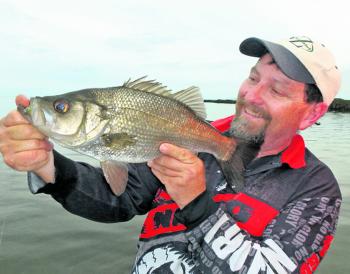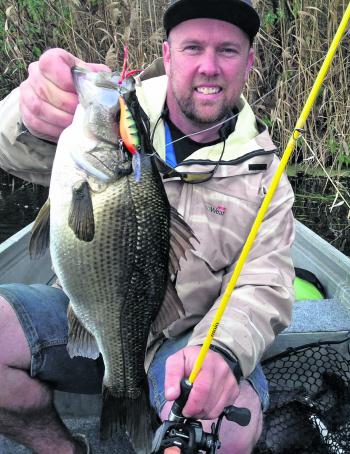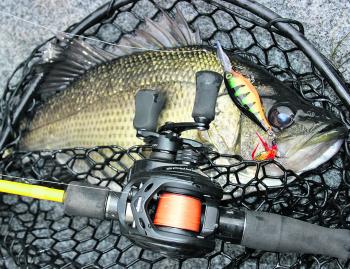Estuary perch weren’t something I took a lot of notice of, or even tried targeting until I was in my twenties. I guess I didn’t have a good understanding for the species and in the early part of my life, wasn’t doing a lot of estuary fishing.
After my first experience with EPs, I understood why anglers got hooked on these fish, pun intended. They are a head down dogged fighter, and if you hook them in the snags, they can make short work of your tackle. They are a challenging fish and this is one of the main reasons they have anglers coming back for more.
In recent times they have been seen to be a bit of a mysterious fish too, and not a species widely spread throughout social media or fishing reports. However, they are in big numbers throughout the southern part of Australia and I chatted to some friends of mine, Brett Geddes and Scott Gray, to get a bit of an insight on the ins and outs of this fish in the EP experience.
For such a secretive fishery, estuary perch are fairly widespread, where is your go-to EP spot?
BG:If someone said to me, “You have got one day in the year, we won’t tell you which day, but you have to catch a perch,” I’m going to go to Anderson Inlet. I’ll say that’s the most prolific perch spot in the world!
SG:On the West Coast we’re pretty lucky in that most estuary systems hold good numbers of perch, some more than others, but I guess the Hopkins River is probably as good as any and my local and favourite.
What are the reasons these areas are so effective?
BG:There’s always a population of fish that inhabit those waters, there’s always those 28-34cm fish that seem to be there year round. I really don’t know why, but they are and that in itself is a major factor of confidence going into that spot. You still have to find them, and that’s the enigmatic part of estuary perch, they can really annoy you, but once located in this system, you are a sure thing of catching a good bag.
SG:There is quite a variety of habitat throughout the system and particularly pushing up into the freshwater. The name of this fish can be a bit misleading really as they spend as much time, if not more, in the freshwater as they do in the estuarine salt. So the structure on offer in the freshwater is something that I see as a major factor of why this area is so good.
What are the best conditions to target EPs?
BG:I like clean water scenarios, and the cleaner the better in my opinion, but outside of that, the condition that’s governed by time of year, and for me that is the November/December spawning time. You can be confident across the whole eastern part of the state at these times because we know they’re spawning, and we know they’ve got it on their brain. The tagging data has actually shown they have two spawning runs, the first is September, October and the second, as stated, is closer up to Christmas.
SG:I always like a rising barometer for most types of fishing, and with that rising barometer, the weather usually becomes finer and stable as well. Low light conditions are also great times of the day to target these fish. They are on offer during the day and night, but I love fishing for them in early morning and late afternoons, as it is such a productive time.
How much of an impact do tides and moons have?
BG:Absolutely huge with tide! Some systems you will not get them on an incoming tide, only on the outgoing. That’s pretty much rule of thumb for any tidal estuary system, they always bite better on an outgoing tide. Of course, there is the odd exception to the rule, but in my book you can chuck it out the window. Always the outgoing tide for me.Moon does nothing for me personally; I haven’t found anything to do with the moon as far as perch are concerned.
SG:Moon is a tough one, and I’ve had some weird things happen with changing moons and perch. There are a lot of variables including moon, tides, flow etc. but I think it just takes a lot of effort in each area to work out which outweighs the other and is more of a factor. To answer that question, I think they do have impacts, but only time on the water will give you the right answer as it does change from area to area.
What are your lure choices?
BG:Always an interesting and tough conversation, but if I think about the lure that I have had the most success with, I can easily say soft plastics that have chartreuse colour in them are it. The 2-3” grubs, fish, wriggler styles… it doesn’t matter, it is simply that colour for me. We hate to come up with theories don’t we, but honestly, I’ve fished side-by-side with others using different colours and chartreuse continues to be it for me. In terms of hard bodies, for me, it is a sinking hardbody, as you tend to get EPs a lot on the drop or in snags where you have to get it in and down a bit.
SG:The go-to plastic would have to be the ZMan GrubZ as a lot of my friends use them and have great success. They’re also a good plastic for other species in the same estuary areas like bream. In terms of hardbodies, I’m a big fan of my suspending minnows, lipless lures as well, vibes too are pretty popular for fishing in the deeper holes. When I get up in the freshwater I do a fair bit of trolling to locate the fish using deep diving minnows. It’s really hard to pick one lure.
What is your ideal outfit… rod, reel, line and leader?
BG: I tend to stick with Nitro rods. They’re 7ft, 2-5kg, fast taper, the reason for this is that you can use them for surface fishing using walkers and small poppers, but also it’s helpful to get in and around snags and has the ability to pull. I usually use about 6kg line with perch. Contrary to beliefs, there’s no finesse with EPs so it doesn’t seem to matter if you run a touch heavier than normal. There’s really no need for 2-4kg line fishing for perch, it’s a bit like Australian salmon, no need to under gun, it won’t make a difference.
SG:I opt for a 7ft rod with a 2500 size reel and 6lb braid is probably a good all round one that I am happy to use on most occasions. If I’m fishing in the freshwater on structure, I’ll upsize things a little. I’d probably go up to 10lb braid and the leader would go up from 6-8lb and occasionally up to 12-15lb leader for structure. The big ones in there will blow you away with anything lighter than 10lb on most occasions.
Best technique for fishing in structure?
BG:In structure, it’s a fairly simple tip, with fishing hard structure like fallen trees or logs or pylons, you really need to make sure you are swimming your lures out very slow. You’ll get a few fish fairly easily off one snag, but after that they might tighten up and become a bit fickle. To get those fish, you must work those lures extra slow and you will get them!
SG:Firstly, you need to find what I call their headquarters. They’ll tend to sit in these areas a lot of the time as they love hanging off the same snag or structure. Generally, I find the largest logs are the best and the ones that have been there the longest time. Then, just remember to get your lures right in there, and don’t be afraid to get in amongst the snag.
Can you give two key points when perch fishing?
BG:Homework! Go with someone who knows perch like the back of their hand. Learn from them, watch them, and emulate them when it’s time to go on your own. The second point is perseverance – undoubtedly the most important point. They have beaten me so many times, yet I didn’t give up and continue to learn from them. So the chances of me catching them these days is now very high.
SG:Persistence is the first and most important thing. Second to that is making sure you are fishing a range of lures and really mixing it up to see what is best on that particular day and spot. Also, a really key and important point would be focusing on those low light conditions, whether early morning or late afternoon.
Have you got an EP highlight?
BG:I went to a small estuary in south Gippsland, I’d never been there and didn’t even know if people had caught perch there. I ended up thinking, this better be worth it because it took me so long to get in there. I finished with 108 fish landed and most of them 45-55cm. I went back a few weeks later, and cracked the hundred mark once again. To this day, this is my highlight. Huge numbers and huge fish. A truly amazing memory.
SG:My biggest estuary perch I have caught is a bit over 2.2kg, but I’ve actually got lots of images in my head of defeat! These are images that are highlights in a way because they make me that much more eager to get back out there. I’ve got memories of getting absolutely smashed up with 15lb leader where I’d like to think that’s strong enough gear, but, as we know, these fish are hard fighters and a fish can be hooked and lost in seconds, which is exactly what drives me to get back out there and try again.
Reads: 3650
The EP bug bit Brett Geddes many years ago, and he still love tangling with these mysterious estuarine predators.

Scott Gray loves getting stuck into a few EPs on the west coast of Vitoria, and who can blame him with fish like this available?

The estuary perch really is a striking fish to look at.




